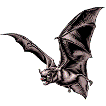Museum, University of Nebraska State

University of Nebraska State Museum: Mammalogy Papers
Document Type
Article
Date of this Version
11-20-1981
Citation
Journal of Mammalogy (1981) 62(4): 665-672.
Abstract
Electrophoretic and albumin immunological data indicate that the Brachyphyllinae as currently conceived is a natural assemblage, with Erophylla sezekorni and Phyllonycteris aphylla being more closely related to each other than either is to Brachyphylla cavernarum. In both data sets, values that distinguish Erophylla from Phyllonycteris are in the general range of values that characterize congeneric species of mammals. Immunological distance values for the species Glossophaga soricina, Monophyllus redmani, Anoura caudifer, Leptonycteris sanborni, Choeroniscus minor, and Hylonycteris underuoodi indicate that these taxa are approximately equidistant from the Brachyphyllinae. Immunological comparisons of Glossophaga and Monophyllus to Anoura, Leptonycteris, Choeroniscus, and Hylonycteris indicate that the four latter genera are more closely related to Glossophaga and Monophyllus than Glossophaga and Monophyllus are to the genera of the Brachyphyllinae. Values from Lonchophylla thomasi and Lionycteris spurrelli suggest a more distant relationship of these glossophagine genera to the Brachyphyllinae than the other glossophagine genera examined. Our data suggest that a 2N = 32, FN = 60 karyotype like that characteristic of Glossophaga is primitive for a clade including the Brachyphyllinae and the glossophagine genera Anoura, Glossophaga, Monophyllus, Leptonycteris, Hylonycteris, and Choeroniscus. These data suggest that the polyphyletic origin of certain glossophagine genera, as proposed by Baker (1967), is unlikely.
Included in
Biodiversity Commons, Immunology of Infectious Disease Commons, Other Ecology and Evolutionary Biology Commons, Zoology Commons


Comments
Copyright 1981, American Society of Mammalogists. Used by permission.